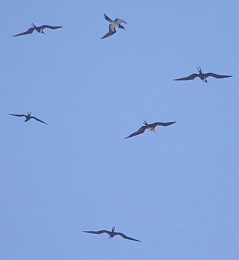
Frigatebirds and a booby in flight
Madagascar Birds
This page highlights some of the Birds of Madagascar.
Copyright © HackingFamily.com with photo
credits to Amanda Hacking 2007
As a large island, geographically isolated for millions of years, Madagascar has the sort of bird diversity one would expect: a relatively low number of species, but a high number of endemics (birds found nowhere else but here). Compared to some of the countries in Africa which have hundreds of species (e.g. Zambia has over 600), Madagascar has 250 species, but a full 40% of them are endemic.
 Frigatebirds and a booby in flight |
The best places to go birding in Madagascar are along the coast and in the
National Parks and Reserves in the interior. Tours can be arranged from
either the capital of Antananarivo ('Tana) or from the island of Nosy Be.
International flights service both Antananarivo and Nose Be. Don't leave
home without a pair of good binoculars and a field guide to the birds of
Madagascar. An excellent book is
Birds of the Indian Ocean Islands
by Ian Sinclair and Olivier Langrand.
There are many bird species that live in the rainforests, but finding them and identifying them in the deeply dappled, shaded forest is difficult. Amanda used a digital Canon Rebel XT camera with a 480 mm lens to capture these bird photos.
Seabirds and Water birds of Madagascar
Sailing around the off-shore islands of western Madagascar we were accompanied by many birds. Some were sea birds such as Terns, Frigatebirds and Boobies, but we also saw coastal birds such as herons and sea eagles. In the photo above, 5 Lesser Frigatebirds Fregata ariel with their forked tails and sharply angled wings soar together with a lone Brown Booby Sula leucogaster (top, center with white breast and underwings - Click the photo for a larger version.) Boobies dive for their fish, but also sometimes harass even larger birds like the Frigatebirds to get them to drop their fish. Brown Boobies are brown on their back and heads, with a white chest and underwing. They have a wingspan of 132‑150 cm (52‑59").
Lesser Frigatebirds have a wing span of 175‑195 cm (5.3‑6 feet) and wheel above the ocean in search of their favorite food, squid. They do occasionally gather surface fish, but often will pirate fish from other seabirds. They use their tail like a rudder to control their acrobatic turns and twists in the air. At times, they soar effortlessly, only occasionally using their strong wings to maintain their altitude over the sea. Male frigatebirds inflate a bright red throat pouch to attract females. The birds nest in colonies in mangroves or other coastal shrubs.
Other Birds
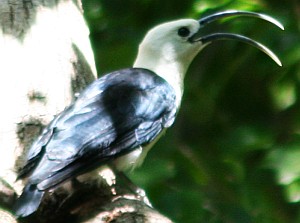 |
Endemic to southern, northern and western Madagascar is the Sickle Billed Vanga Falculea palliata. These birds are distinctive with their black and white plumage and long gray decurved bill. Taking the ecological niche filled by woodpeckers elsewhere in the world, these birds cling to branches and trunks, probing the bark for insects with their long bills. They live in deciduous dry forest and thorn scrub. They are about 32 cm (6") tall and are often in groups. When flying their wings make a soft wooshing sound. |
| Found in many habitats, the Madagascar Bee Eater Mersops superciliosus is a lovely bird with its green breast, russet neck and crown, and black mask across a white face. It lives on a diet of not only bees, but also butterflies, insects, wasps, and grasshoppers. Although field guides say this bee eater prefers wetter climes such as mangroves and rainforests, we saw these birds hovering about their nests in arid sandstone cliffs in northern Madagascar. The birds are also found in the Seychelles and East Africa. They breed in Madagascar and the Comoros Islands. |
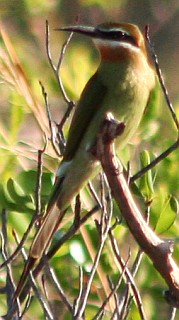 |
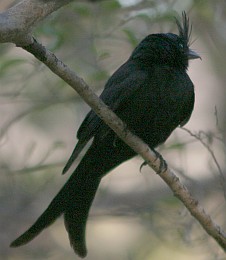 |
The Crested Drongo Dicruruius forficatus is 26 cm (10") long and is endemic to northern Madagascar and the island of Nosy Be. Crested Drongos often mob other birds. They have a variety of calls and whistles and have an unmistakable jizz -- all black with a high crest and forked tail. |
| The lovely small Stone Chat (left) Saxicola spp. is quite at home in the harsh environment of limestone tsingy of northern Madagascar. Unafraid of humans, this small bird hopped about trying to get closer to our picnic lunch. Distinctive with its black head and back, white shoulder and russet chest, it is related to the Stone Chats of Africa. |
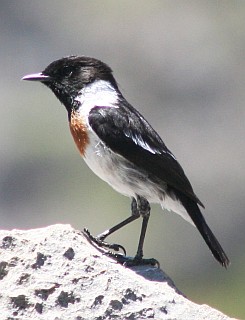 |
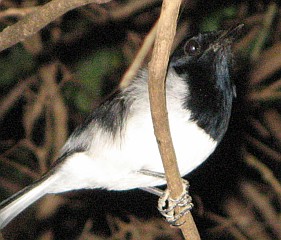 |
A lovely bird, with its black and white suit of feathers. But alas, we have no ID on it because we were unable to use a field guide shortly after leaving the mountains of Northern Madagascar. The photo was taken in October, in Réserve Spéciale de l'Ankárana in northern Madagascar. Please contact us if you can help with its identity. |
Top Level: Home | Destinations | Cruising Info | Underwater | Boat Guests | Ocelot | Sue | Jon | Amanda | Chris | Site Map | Make a Comment
|
If our information is useful, you can help by making a donation |
Copyright © 2000‑ Contact: Jon and Sue Hacking -- HackingFamily.com, svOcelot.com. All rights reserved.